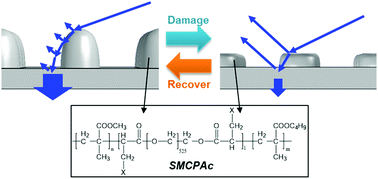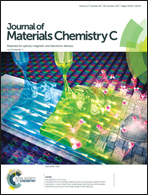Sustainable antireflection using recoverable nanopattern arrays†
Abstract
Antireflection (AR) nanostructures mimicking a moth's eye have been developed for optical devices to achieve a high transmittance of light energy. However, mechanical vulnerability has always been pointed out as a drawback of these nanostructures. This research proposes a unique AR strategy which is to infuse shape recovery ability into nanopattern arrays for obtaining high sustainability of the AR nanostructures. A shape memory polymer (SMP) was prepared through tri-copolymerization, where the transition temperature was modulated close to body temperature for facile shape recovery. Nanoscale shape recoverability of the patterns was explored at body temperature. Light transmittance was analyzed experimentally according to the shape state of the AR nanopatterns, and the shape recovery function restored 50% of the damaged antireflection performance. The underlying mechanism of the sustainable AR based on nanopatterns was suggested by calculating theoretical transmittance. Omnidirectional antireflectivity by the nanopatterns was examined by measuring oblique incident transmittances with their sustainability. The nanomechanical properties and the sustainable self-cleaning effect induced by the smart nanostructures were also confirmed experimentally. We foresee that the approach suggested in this study can provide new insights into biomimetic optics.



 Please wait while we load your content...
Please wait while we load your content...